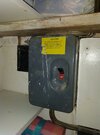The two screws come out and allow the front to come off when the main switch is off. Usually you get two 30A carriers, and either two 15A, or one 15A and one 5A. these were used for standard domestic installations where you would have a 30A sockets ring, 30A cooker, 15A immersion heater and 5A lights. The carriers may also contain asbestos flash pads
What colour are the cables comming out the top, do they have black outer insulation like they look like they might do, or is it just poor lighting?
That board is long overdue for replacement, being circa 50 years old. I assume you are asking because you have an appliance retailer connecting a cooker to the cooker cirucit - I have no idea how they would react to seeing that board, they'd possibly decide because there isn't an MCB silkscreened with 30 or 32A that they don't know how to proceed
But if you have a 6mm cooker cirucit in your kitchen, realistically its going to be on a 30A fuse in there


